Holmes Institute - Accounting for Business Assignment T1 2019
VerifiedAdded on 2022/11/26
|6
|1184
|234
Homework Assignment
AI Summary
This assignment provides a comprehensive analysis of financial statements, focusing on key accounting ratios and their implications. Part A delves into the calculation and interpretation of current ratio, quick ratio, accounts receivable turnover, and inventory turnover, examining their trends and significance for short-term liquidity and efficiency. Part B defines income and revenue, differentiating between the two and applying these concepts to specific financial items of a software company, clarifying which transactions constitute revenue. Part C presents a case study involving a short-term loan, comparing the financial health of two potential borrowers, XYZ and ABC, based on current ratios and other financial considerations, including the impact of liabilities and asset bases on loan decisions. The assignment incorporates relevant accounting standards and references to support its analysis.
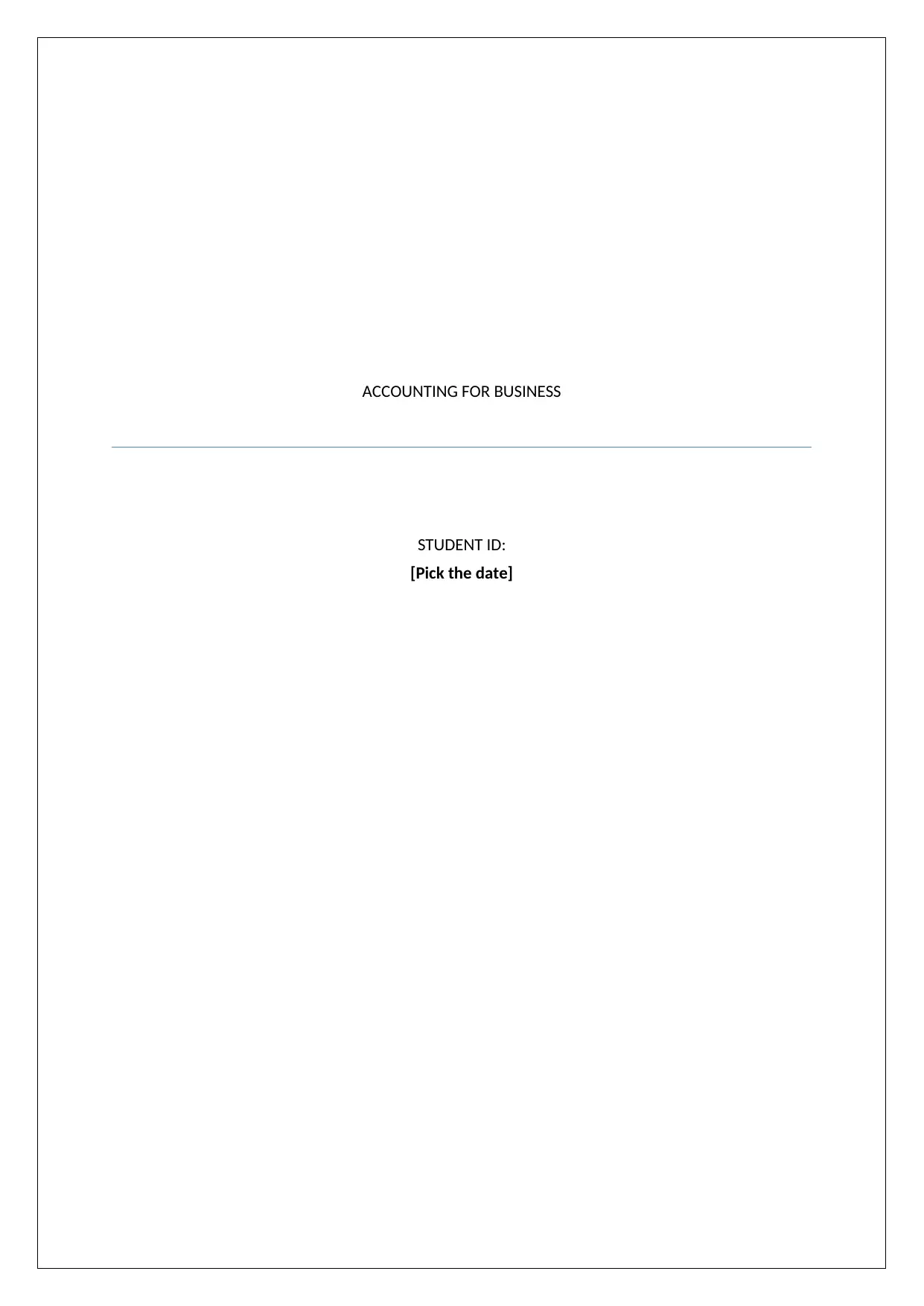
ACCOUNTING FOR BUSINESS
STUDENT ID:
[Pick the date]
STUDENT ID:
[Pick the date]
Paraphrase This Document
Need a fresh take? Get an instant paraphrase of this document with our AI Paraphraser
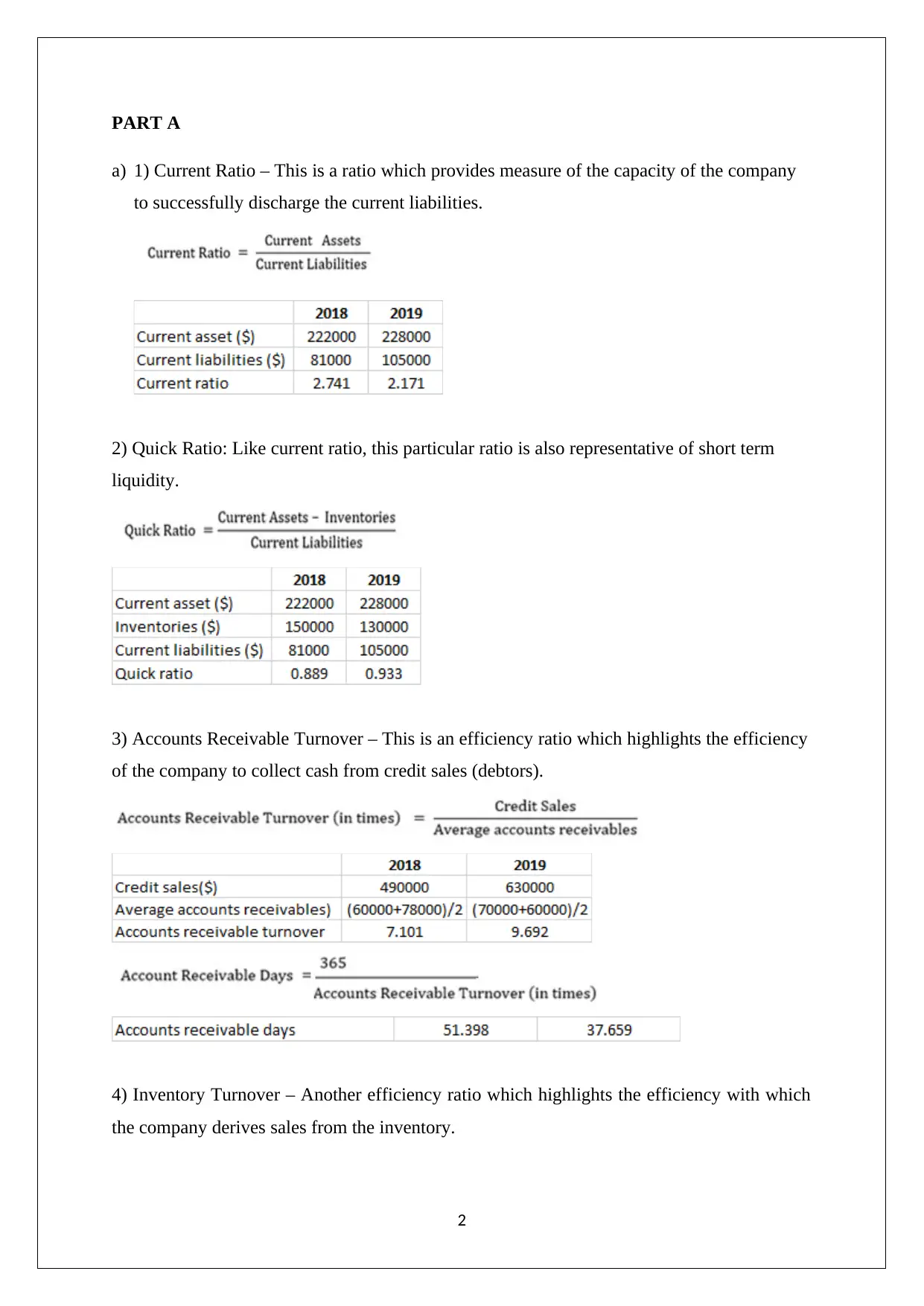
PART A
a) 1) Current Ratio – This is a ratio which provides measure of the capacity of the company
to successfully discharge the current liabilities.
2) Quick Ratio: Like current ratio, this particular ratio is also representative of short term
liquidity.
3) Accounts Receivable Turnover – This is an efficiency ratio which highlights the efficiency
of the company to collect cash from credit sales (debtors).
4) Inventory Turnover – Another efficiency ratio which highlights the efficiency with which
the company derives sales from the inventory.
2
a) 1) Current Ratio – This is a ratio which provides measure of the capacity of the company
to successfully discharge the current liabilities.
2) Quick Ratio: Like current ratio, this particular ratio is also representative of short term
liquidity.
3) Accounts Receivable Turnover – This is an efficiency ratio which highlights the efficiency
of the company to collect cash from credit sales (debtors).
4) Inventory Turnover – Another efficiency ratio which highlights the efficiency with which
the company derives sales from the inventory.
2
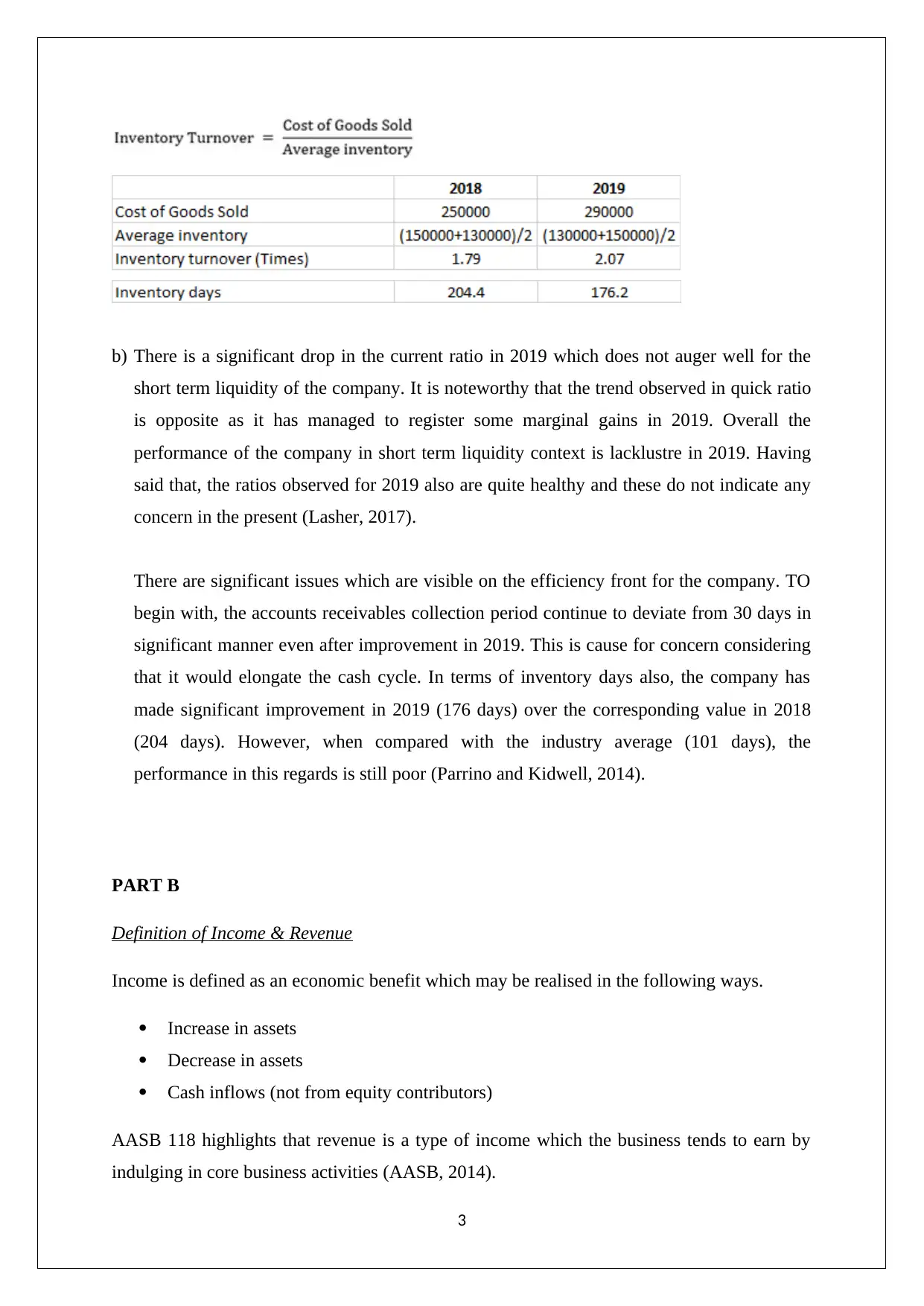
b) There is a significant drop in the current ratio in 2019 which does not auger well for the
short term liquidity of the company. It is noteworthy that the trend observed in quick ratio
is opposite as it has managed to register some marginal gains in 2019. Overall the
performance of the company in short term liquidity context is lacklustre in 2019. Having
said that, the ratios observed for 2019 also are quite healthy and these do not indicate any
concern in the present (Lasher, 2017).
There are significant issues which are visible on the efficiency front for the company. TO
begin with, the accounts receivables collection period continue to deviate from 30 days in
significant manner even after improvement in 2019. This is cause for concern considering
that it would elongate the cash cycle. In terms of inventory days also, the company has
made significant improvement in 2019 (176 days) over the corresponding value in 2018
(204 days). However, when compared with the industry average (101 days), the
performance in this regards is still poor (Parrino and Kidwell, 2014).
PART B
Definition of Income & Revenue
Income is defined as an economic benefit which may be realised in the following ways.
Increase in assets
Decrease in assets
Cash inflows (not from equity contributors)
AASB 118 highlights that revenue is a type of income which the business tends to earn by
indulging in core business activities (AASB, 2014).
3
short term liquidity of the company. It is noteworthy that the trend observed in quick ratio
is opposite as it has managed to register some marginal gains in 2019. Overall the
performance of the company in short term liquidity context is lacklustre in 2019. Having
said that, the ratios observed for 2019 also are quite healthy and these do not indicate any
concern in the present (Lasher, 2017).
There are significant issues which are visible on the efficiency front for the company. TO
begin with, the accounts receivables collection period continue to deviate from 30 days in
significant manner even after improvement in 2019. This is cause for concern considering
that it would elongate the cash cycle. In terms of inventory days also, the company has
made significant improvement in 2019 (176 days) over the corresponding value in 2018
(204 days). However, when compared with the industry average (101 days), the
performance in this regards is still poor (Parrino and Kidwell, 2014).
PART B
Definition of Income & Revenue
Income is defined as an economic benefit which may be realised in the following ways.
Increase in assets
Decrease in assets
Cash inflows (not from equity contributors)
AASB 118 highlights that revenue is a type of income which the business tends to earn by
indulging in core business activities (AASB, 2014).
3
⊘ This is a preview!⊘
Do you want full access?
Subscribe today to unlock all pages.

Trusted by 1+ million students worldwide
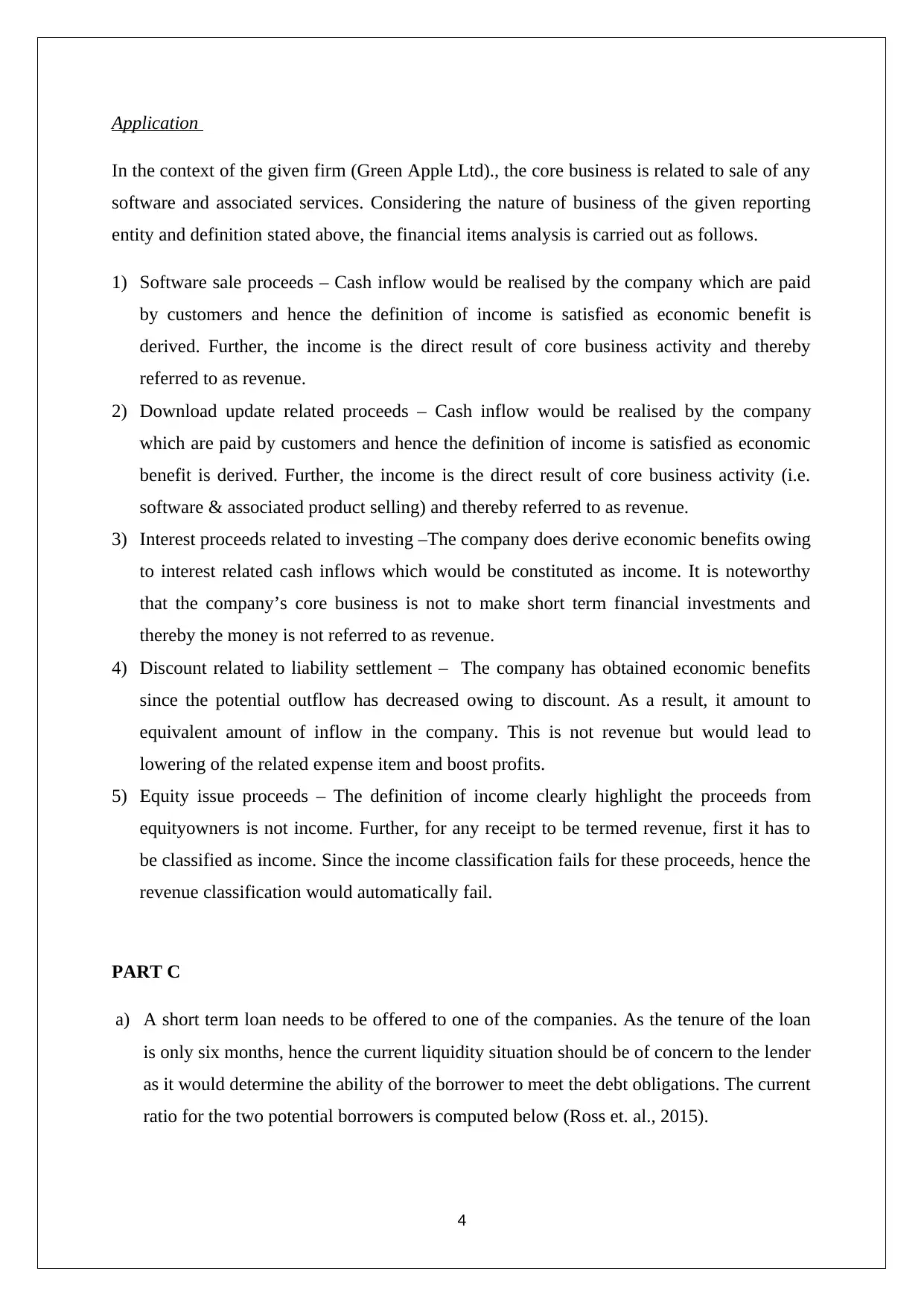
Application
In the context of the given firm (Green Apple Ltd)., the core business is related to sale of any
software and associated services. Considering the nature of business of the given reporting
entity and definition stated above, the financial items analysis is carried out as follows.
1) Software sale proceeds – Cash inflow would be realised by the company which are paid
by customers and hence the definition of income is satisfied as economic benefit is
derived. Further, the income is the direct result of core business activity and thereby
referred to as revenue.
2) Download update related proceeds – Cash inflow would be realised by the company
which are paid by customers and hence the definition of income is satisfied as economic
benefit is derived. Further, the income is the direct result of core business activity (i.e.
software & associated product selling) and thereby referred to as revenue.
3) Interest proceeds related to investing –The company does derive economic benefits owing
to interest related cash inflows which would be constituted as income. It is noteworthy
that the company’s core business is not to make short term financial investments and
thereby the money is not referred to as revenue.
4) Discount related to liability settlement – The company has obtained economic benefits
since the potential outflow has decreased owing to discount. As a result, it amount to
equivalent amount of inflow in the company. This is not revenue but would lead to
lowering of the related expense item and boost profits.
5) Equity issue proceeds – The definition of income clearly highlight the proceeds from
equityowners is not income. Further, for any receipt to be termed revenue, first it has to
be classified as income. Since the income classification fails for these proceeds, hence the
revenue classification would automatically fail.
PART C
a) A short term loan needs to be offered to one of the companies. As the tenure of the loan
is only six months, hence the current liquidity situation should be of concern to the lender
as it would determine the ability of the borrower to meet the debt obligations. The current
ratio for the two potential borrowers is computed below (Ross et. al., 2015).
4
In the context of the given firm (Green Apple Ltd)., the core business is related to sale of any
software and associated services. Considering the nature of business of the given reporting
entity and definition stated above, the financial items analysis is carried out as follows.
1) Software sale proceeds – Cash inflow would be realised by the company which are paid
by customers and hence the definition of income is satisfied as economic benefit is
derived. Further, the income is the direct result of core business activity and thereby
referred to as revenue.
2) Download update related proceeds – Cash inflow would be realised by the company
which are paid by customers and hence the definition of income is satisfied as economic
benefit is derived. Further, the income is the direct result of core business activity (i.e.
software & associated product selling) and thereby referred to as revenue.
3) Interest proceeds related to investing –The company does derive economic benefits owing
to interest related cash inflows which would be constituted as income. It is noteworthy
that the company’s core business is not to make short term financial investments and
thereby the money is not referred to as revenue.
4) Discount related to liability settlement – The company has obtained economic benefits
since the potential outflow has decreased owing to discount. As a result, it amount to
equivalent amount of inflow in the company. This is not revenue but would lead to
lowering of the related expense item and boost profits.
5) Equity issue proceeds – The definition of income clearly highlight the proceeds from
equityowners is not income. Further, for any receipt to be termed revenue, first it has to
be classified as income. Since the income classification fails for these proceeds, hence the
revenue classification would automatically fail.
PART C
a) A short term loan needs to be offered to one of the companies. As the tenure of the loan
is only six months, hence the current liquidity situation should be of concern to the lender
as it would determine the ability of the borrower to meet the debt obligations. The current
ratio for the two potential borrowers is computed below (Ross et. al., 2015).
4
Paraphrase This Document
Need a fresh take? Get an instant paraphrase of this document with our AI Paraphraser
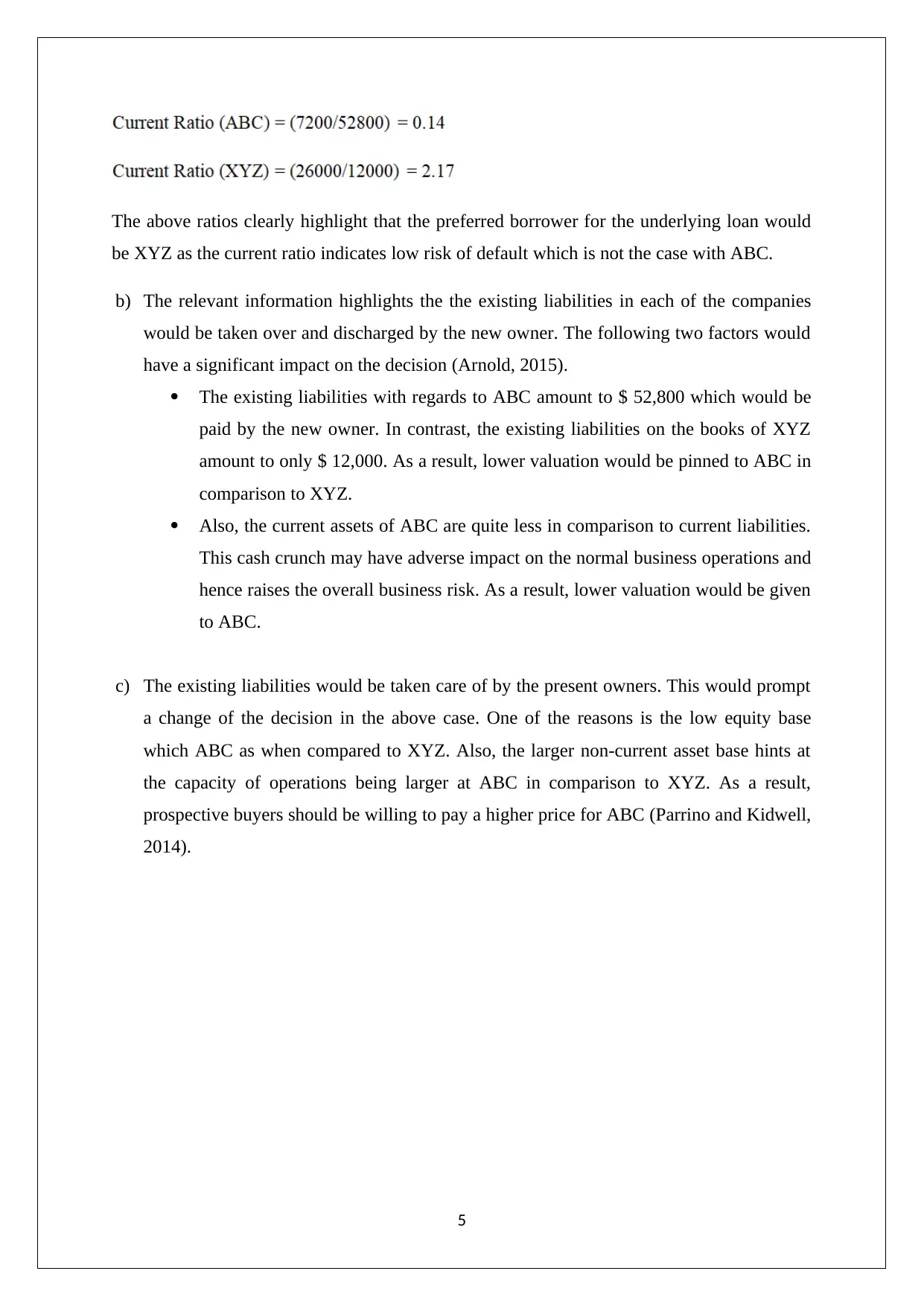
The above ratios clearly highlight that the preferred borrower for the underlying loan would
be XYZ as the current ratio indicates low risk of default which is not the case with ABC.
b) The relevant information highlights the the existing liabilities in each of the companies
would be taken over and discharged by the new owner. The following two factors would
have a significant impact on the decision (Arnold, 2015).
The existing liabilities with regards to ABC amount to $ 52,800 which would be
paid by the new owner. In contrast, the existing liabilities on the books of XYZ
amount to only $ 12,000. As a result, lower valuation would be pinned to ABC in
comparison to XYZ.
Also, the current assets of ABC are quite less in comparison to current liabilities.
This cash crunch may have adverse impact on the normal business operations and
hence raises the overall business risk. As a result, lower valuation would be given
to ABC.
c) The existing liabilities would be taken care of by the present owners. This would prompt
a change of the decision in the above case. One of the reasons is the low equity base
which ABC as when compared to XYZ. Also, the larger non-current asset base hints at
the capacity of operations being larger at ABC in comparison to XYZ. As a result,
prospective buyers should be willing to pay a higher price for ABC (Parrino and Kidwell,
2014).
5
be XYZ as the current ratio indicates low risk of default which is not the case with ABC.
b) The relevant information highlights the the existing liabilities in each of the companies
would be taken over and discharged by the new owner. The following two factors would
have a significant impact on the decision (Arnold, 2015).
The existing liabilities with regards to ABC amount to $ 52,800 which would be
paid by the new owner. In contrast, the existing liabilities on the books of XYZ
amount to only $ 12,000. As a result, lower valuation would be pinned to ABC in
comparison to XYZ.
Also, the current assets of ABC are quite less in comparison to current liabilities.
This cash crunch may have adverse impact on the normal business operations and
hence raises the overall business risk. As a result, lower valuation would be given
to ABC.
c) The existing liabilities would be taken care of by the present owners. This would prompt
a change of the decision in the above case. One of the reasons is the low equity base
which ABC as when compared to XYZ. Also, the larger non-current asset base hints at
the capacity of operations being larger at ABC in comparison to XYZ. As a result,
prospective buyers should be willing to pay a higher price for ABC (Parrino and Kidwell,
2014).
5
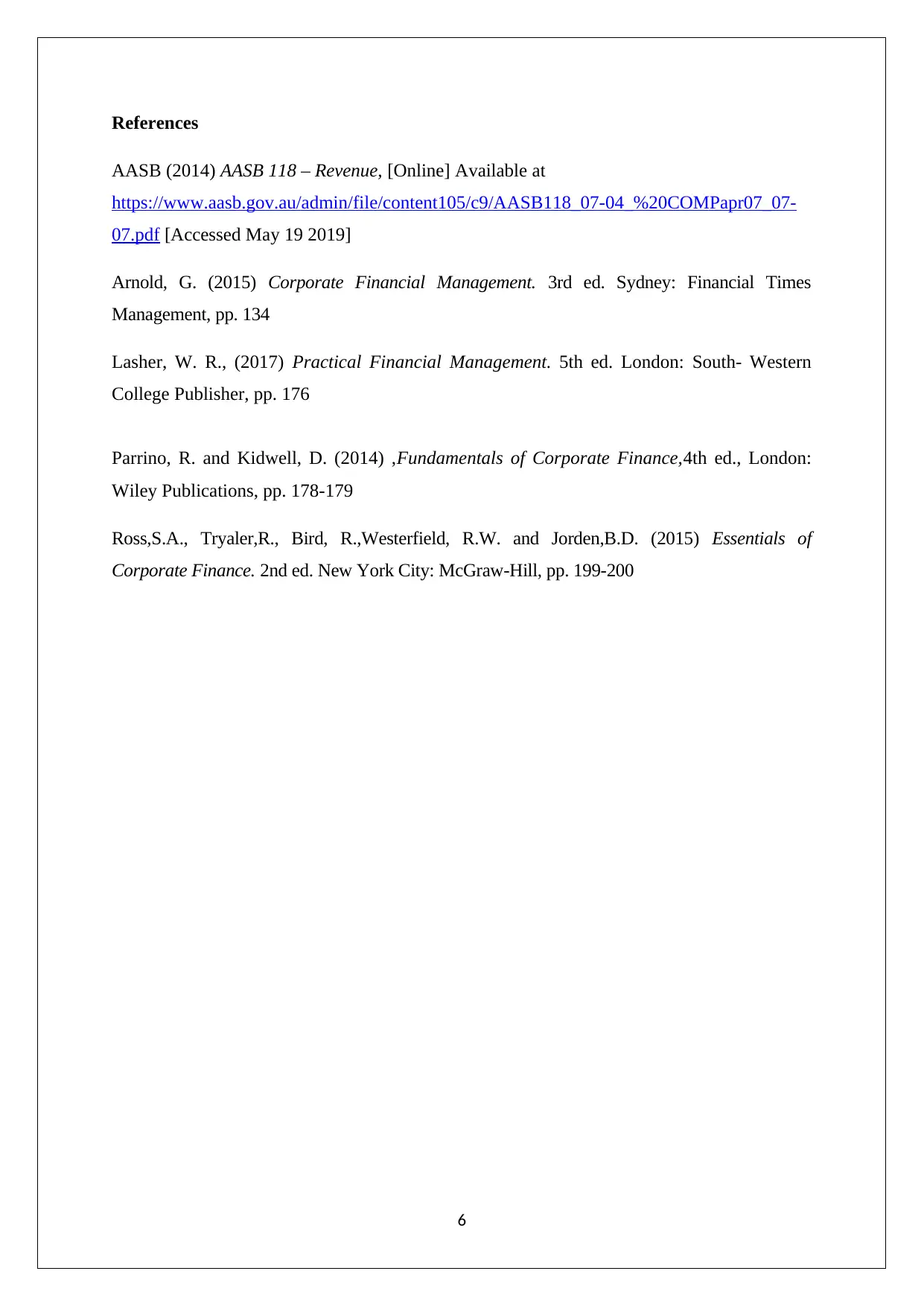
References
AASB (2014) AASB 118 – Revenue, [Online] Available at
https://www.aasb.gov.au/admin/file/content105/c9/AASB118_07-04_%20COMPapr07_07-
07.pdf [Accessed May 19 2019]
Arnold, G. (2015) Corporate Financial Management. 3rd ed. Sydney: Financial Times
Management, pp. 134
Lasher, W. R., (2017) Practical Financial Management. 5th ed. London: South- Western
College Publisher, pp. 176
Parrino, R. and Kidwell, D. (2014) ,Fundamentals of Corporate Finance,4th ed., London:
Wiley Publications, pp. 178-179
Ross,S.A., Tryaler,R., Bird, R.,Westerfield, R.W. and Jorden,B.D. (2015) Essentials of
Corporate Finance. 2nd ed. New York City: McGraw-Hill, pp. 199-200
6
AASB (2014) AASB 118 – Revenue, [Online] Available at
https://www.aasb.gov.au/admin/file/content105/c9/AASB118_07-04_%20COMPapr07_07-
07.pdf [Accessed May 19 2019]
Arnold, G. (2015) Corporate Financial Management. 3rd ed. Sydney: Financial Times
Management, pp. 134
Lasher, W. R., (2017) Practical Financial Management. 5th ed. London: South- Western
College Publisher, pp. 176
Parrino, R. and Kidwell, D. (2014) ,Fundamentals of Corporate Finance,4th ed., London:
Wiley Publications, pp. 178-179
Ross,S.A., Tryaler,R., Bird, R.,Westerfield, R.W. and Jorden,B.D. (2015) Essentials of
Corporate Finance. 2nd ed. New York City: McGraw-Hill, pp. 199-200
6
⊘ This is a preview!⊘
Do you want full access?
Subscribe today to unlock all pages.

Trusted by 1+ million students worldwide
1 out of 6
Related Documents
Your All-in-One AI-Powered Toolkit for Academic Success.
+13062052269
info@desklib.com
Available 24*7 on WhatsApp / Email
![[object Object]](/_next/static/media/star-bottom.7253800d.svg)
Unlock your academic potential
Copyright © 2020–2025 A2Z Services. All Rights Reserved. Developed and managed by ZUCOL.





